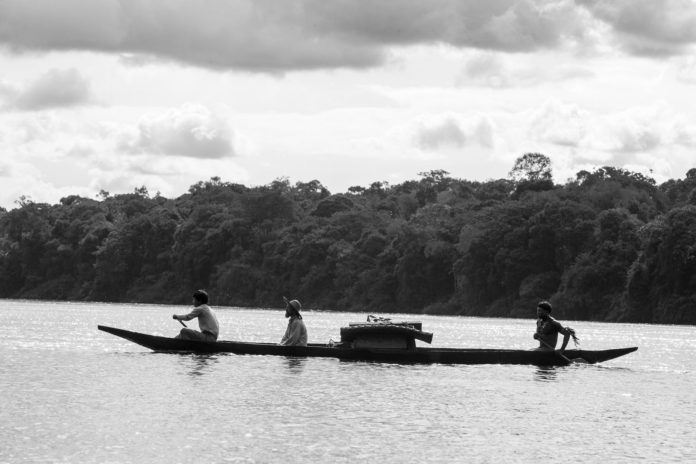“Embrace of the Serpent” has some of the most vivid images captured on film in recent memory, and also some of the most haunting. One moment a dying man is engulfed in a cloud of butterflies, and the next, a scarred, one-armed slave is begging someone – anyone – to kill him. It isn’t easy to shake off, with its thematic echoes of “Heart of Darkness” and its brutal, beautiful Amazonian jungle setting.
The Colombian movie, which was nominated for a foreign-language Academy Award, takes its time telling two stories, which unfold, in parallel, 30 years apart. In 1909, a deathly ill German ethnologist is escorted by his assistant to a shaman, who lives alone in the forest. The sickly, aged Theo (Jan Bijvoet) and his indigenous companion, Manduca (Yauenkü Migue), want Karamakate (Nilbio Torres) to help them find yakruna, a sacred plant with healing properties and psychedelic side effects.
At first Karamakate refuses. He doesn’t trust white men, and who could blame him? Rubber profiteers and missionaries have ravaged his home and wiped out or enslaved his people. But after Theo promises to take Karamakate to his kinsmen – a tribe the shaman thought had been exterminated – the men strike a deal. The three set out together on the river, paddling through the jungle in search of their individual salvations.
Decades later, an older Karamakate (Antonio Bolivar) is once again visited by a white man. Evan (Brionne Davis) is a young American who has devoted his life to studying rare plants. Using Theo’s diary from decades earlier as a manual, Evan also is searching for yakruna. The old man’s memory has faded, and he can’t quite recall where to go. But he tags along with Evan anyway, snaking his way down the river, guided by dreams, myths and the mystical voices of his ancestors.
Directed by Ciro Guerra, “Serpent” was filmed in a remote area of Colombia and shot in black and white – with one exception during the finale – using mostly non-professional actors (although you’d never know it). You’ll be too distracted by David Gallego’s showstopping cinematography, which delivers one indelible image after another.
Like Joseph Conrad’s “Heart of Darkness” (and the movie it inspired, “Apocalypse Now”), the drama examines the idea of progress and what it means to be civilized. Some of the most disturbing scenes take place at a mission that Karamakate visits during both chapters of the story. On the earlier trip, the place is run by a brutal Spanish priest who takes in orphans. A plaque at the mission heralds the spot where Catholic men converted the region’s “savage cannibals.” Years later, the mission has become the domain of a cult leader who thinks he’s Jesus and encourages self-flagellation and ritual suicide. Progress sure looks dismal.
And yet “Embrace of the Serpent” isn’t a heavy-handed movie with a moral so much as a surreal and transporting parable, told from the perspective of one tribe’s last standard bearer. The movie was inspired by the travel journals of ethnologist Theodor Koch-Grunberg and biologist Richard Evans Schultes, which shed light on Amazonian cultures that history might have otherwise forgotten.
Guerra dedicates the movie to the other indigenous people – the ones we know nothing about. Their customs and cultures might have disappeared, but the director does them justice all the same, with a brilliant, atmospheric reimagining of one man’s rich and remarkable life.
—
Three and a half stars. Unrated. Contains nudity, violence against children, drug use and disturbing images. In Spanish, Portuguese, German, Catalan, Latin and indigenous Amazonian languages with subtitles. 125 minutes.
Ratings Guide: Four stars masterpiece, three stars very good, two stars OK, one star poor, no stars waste of time.






